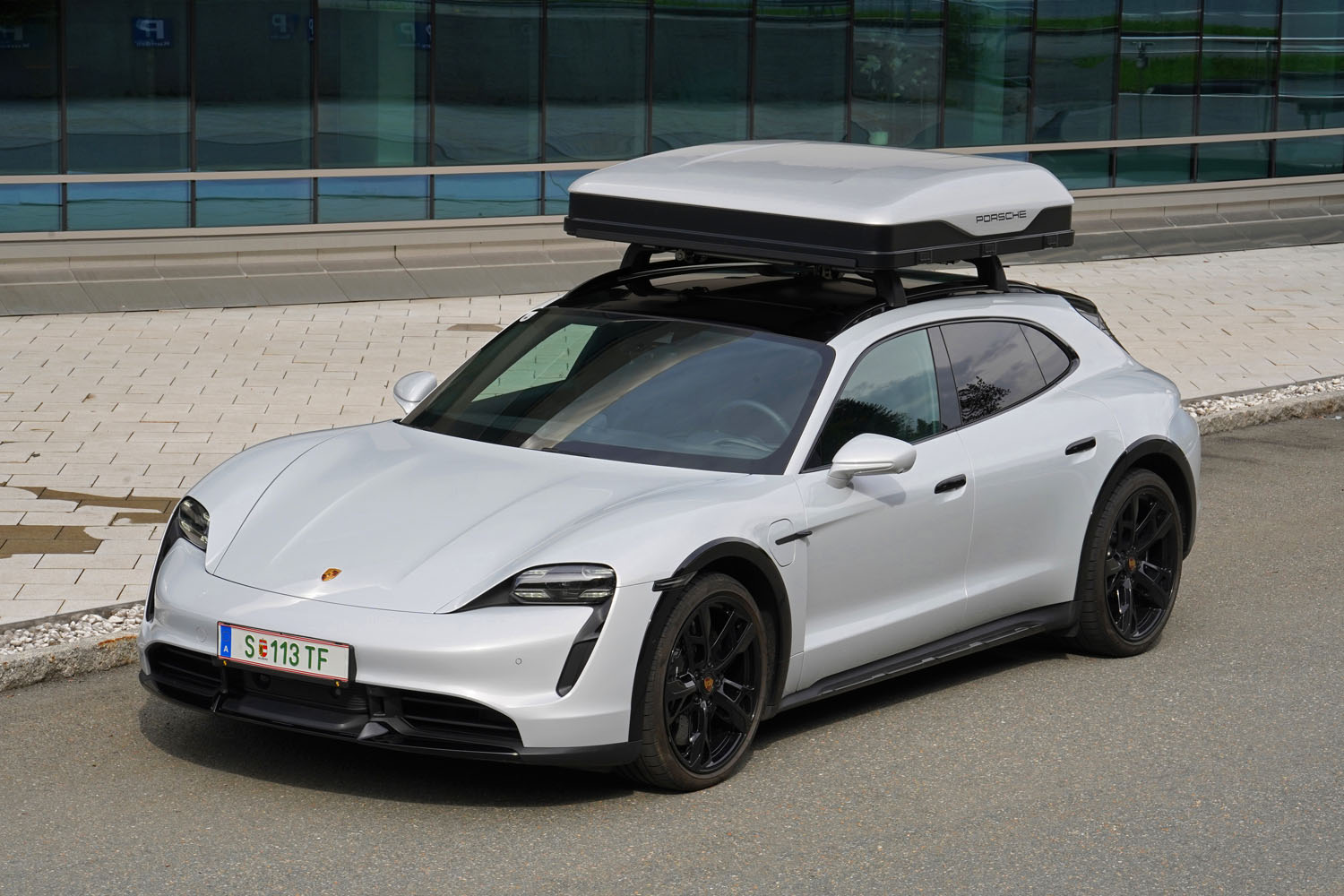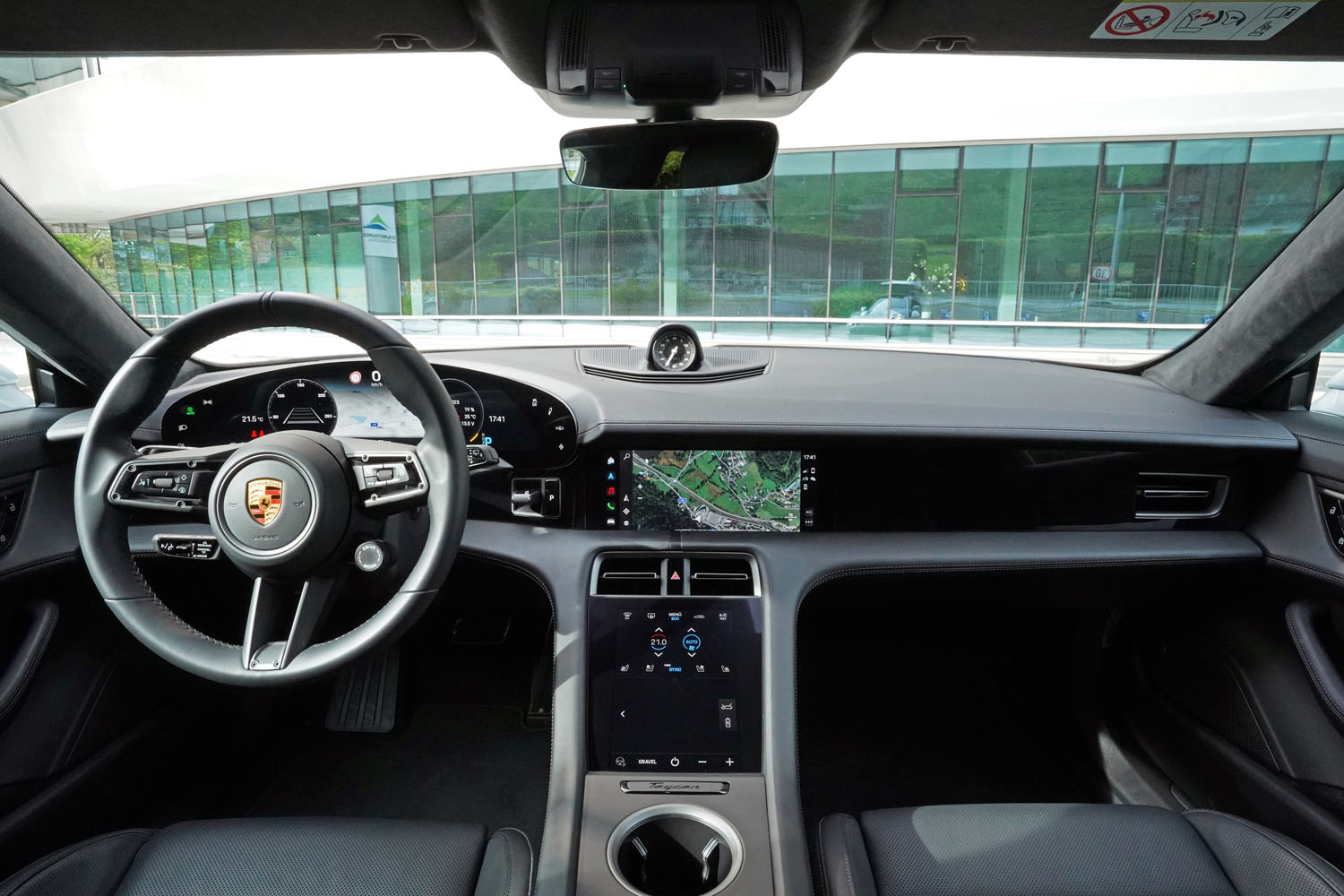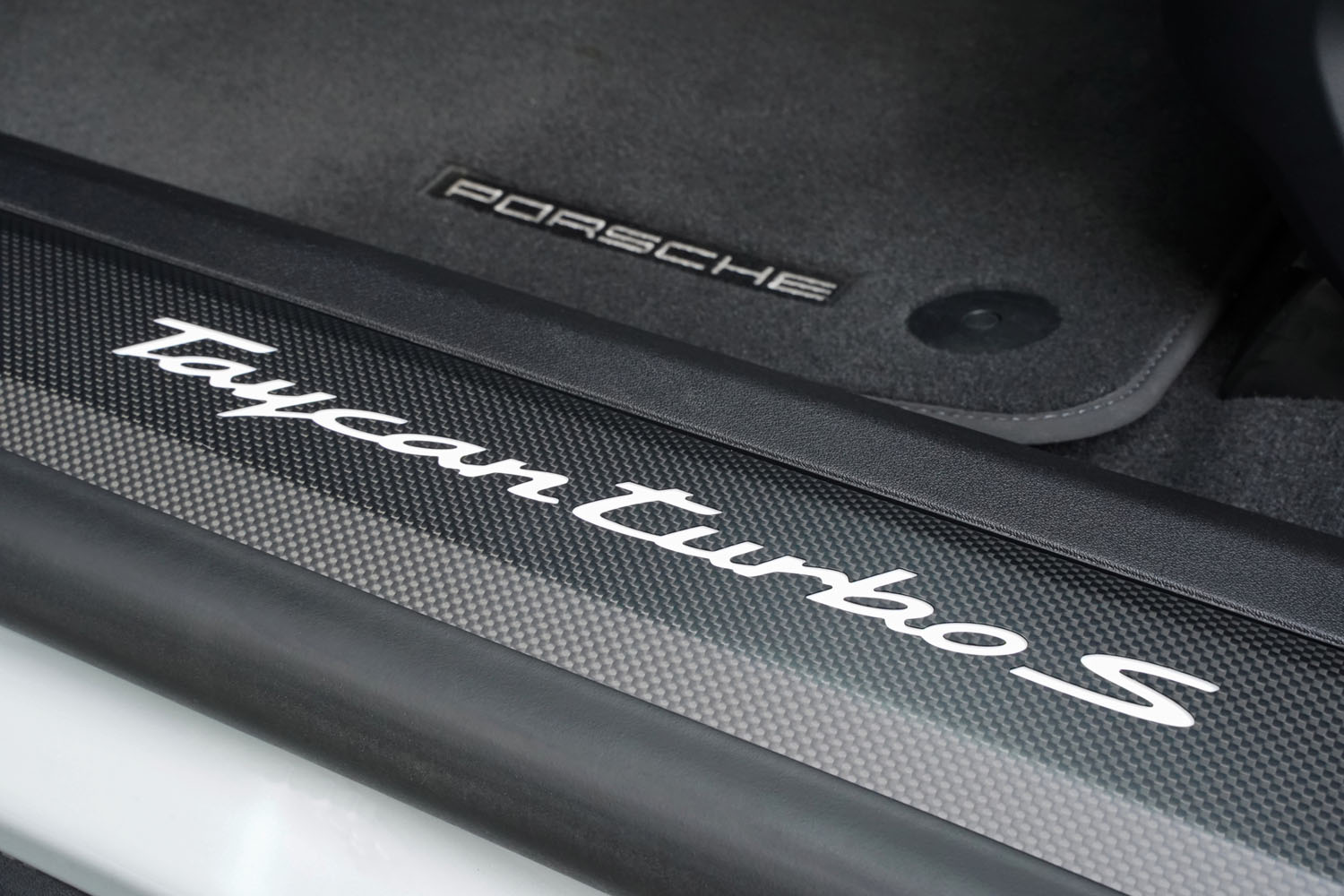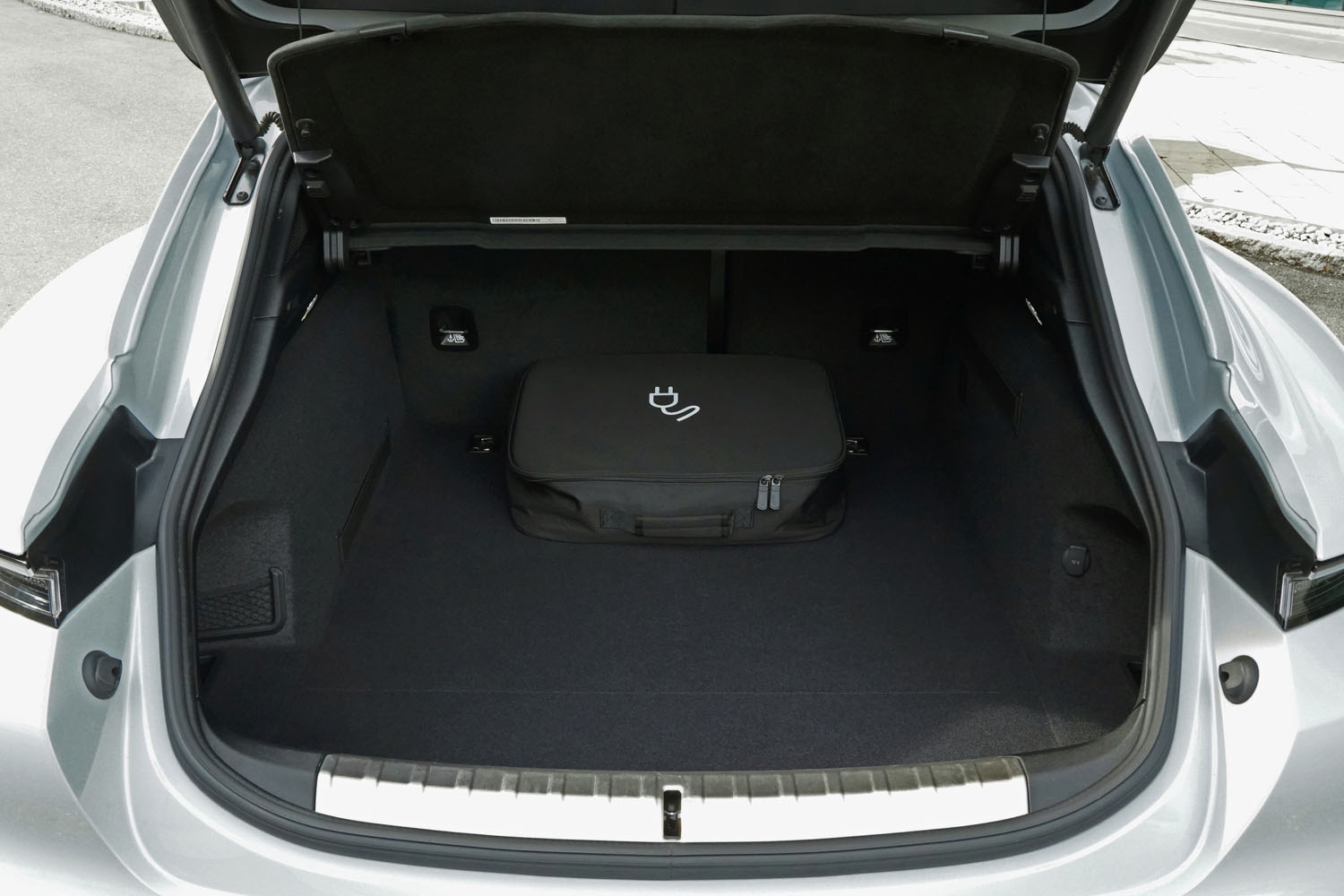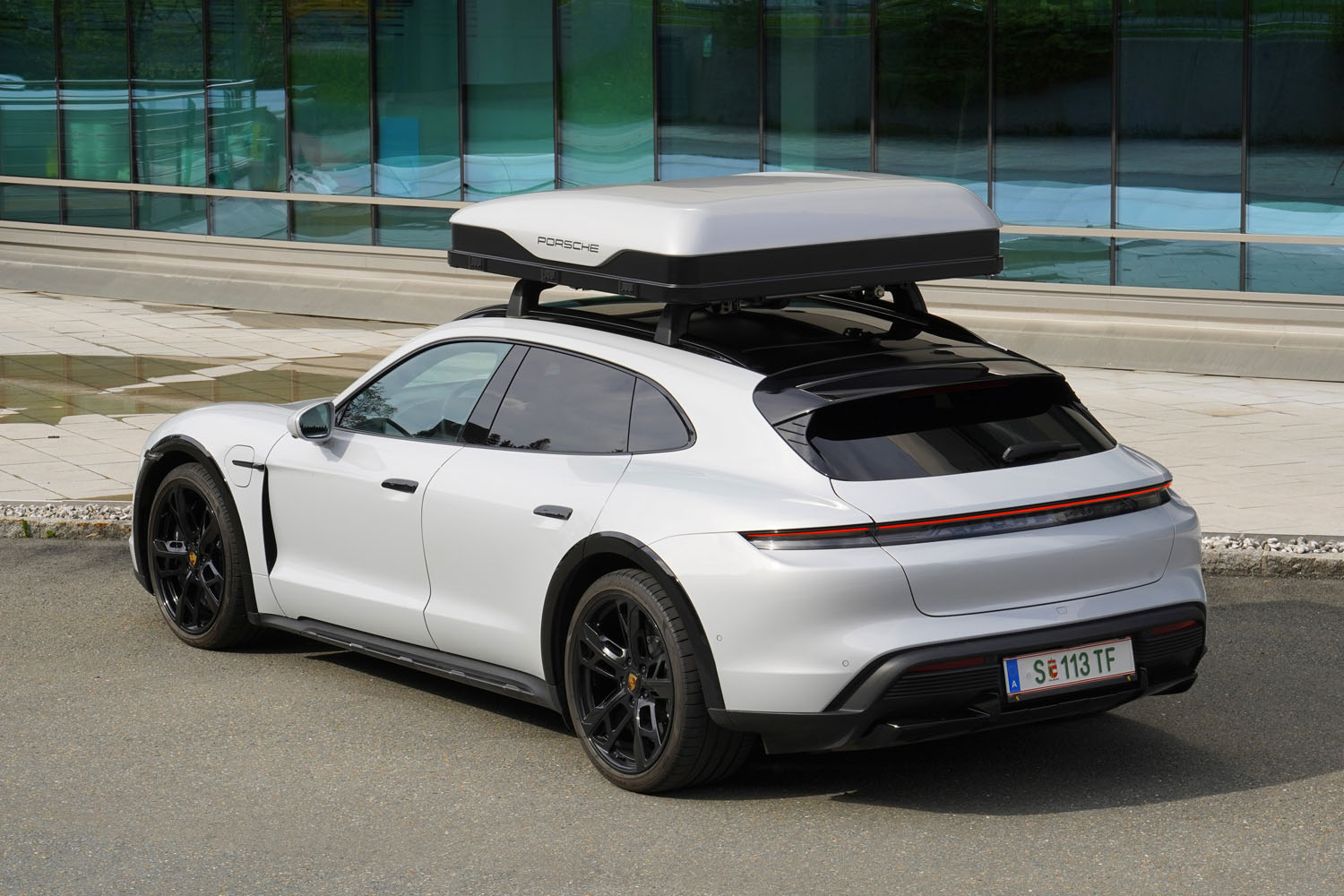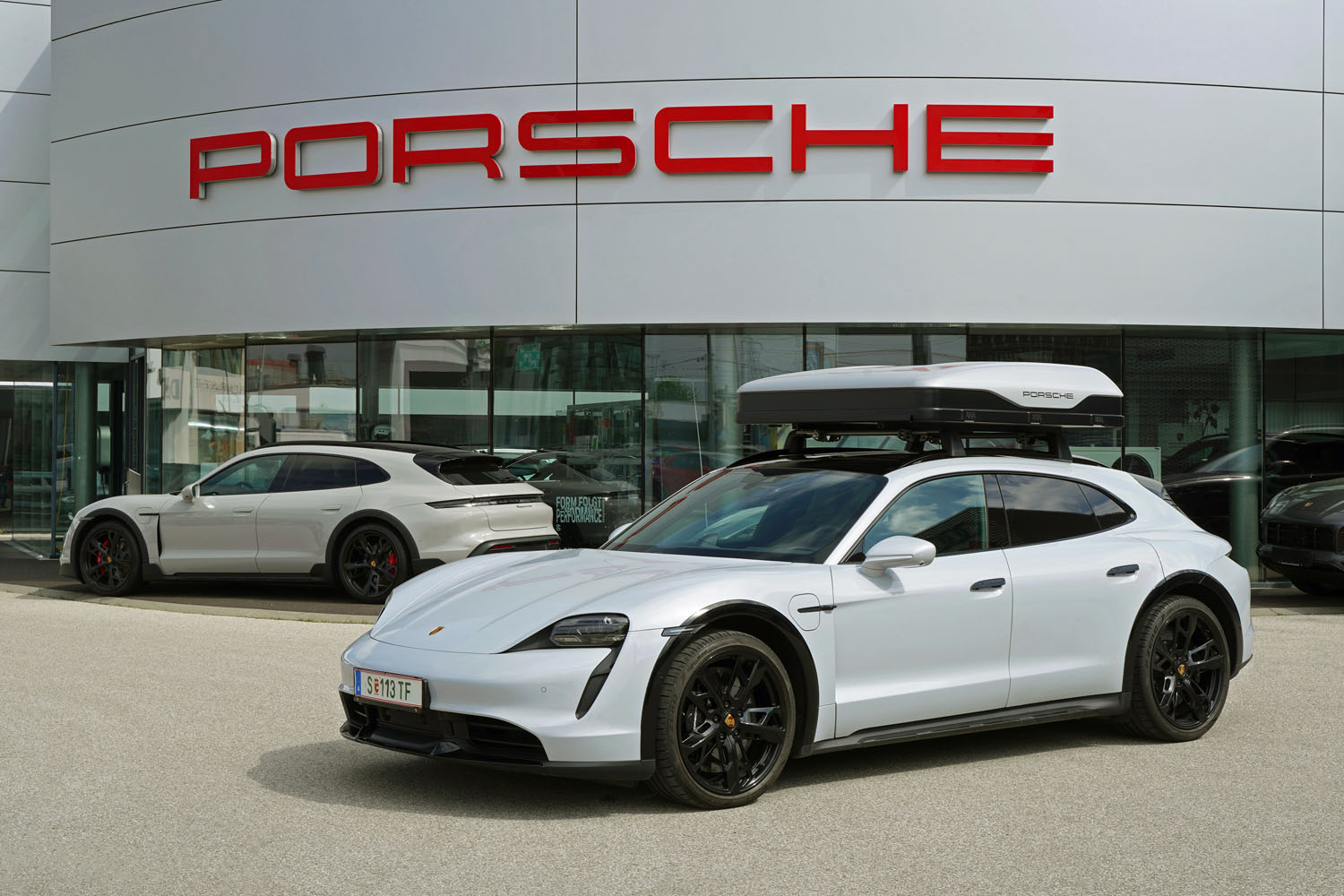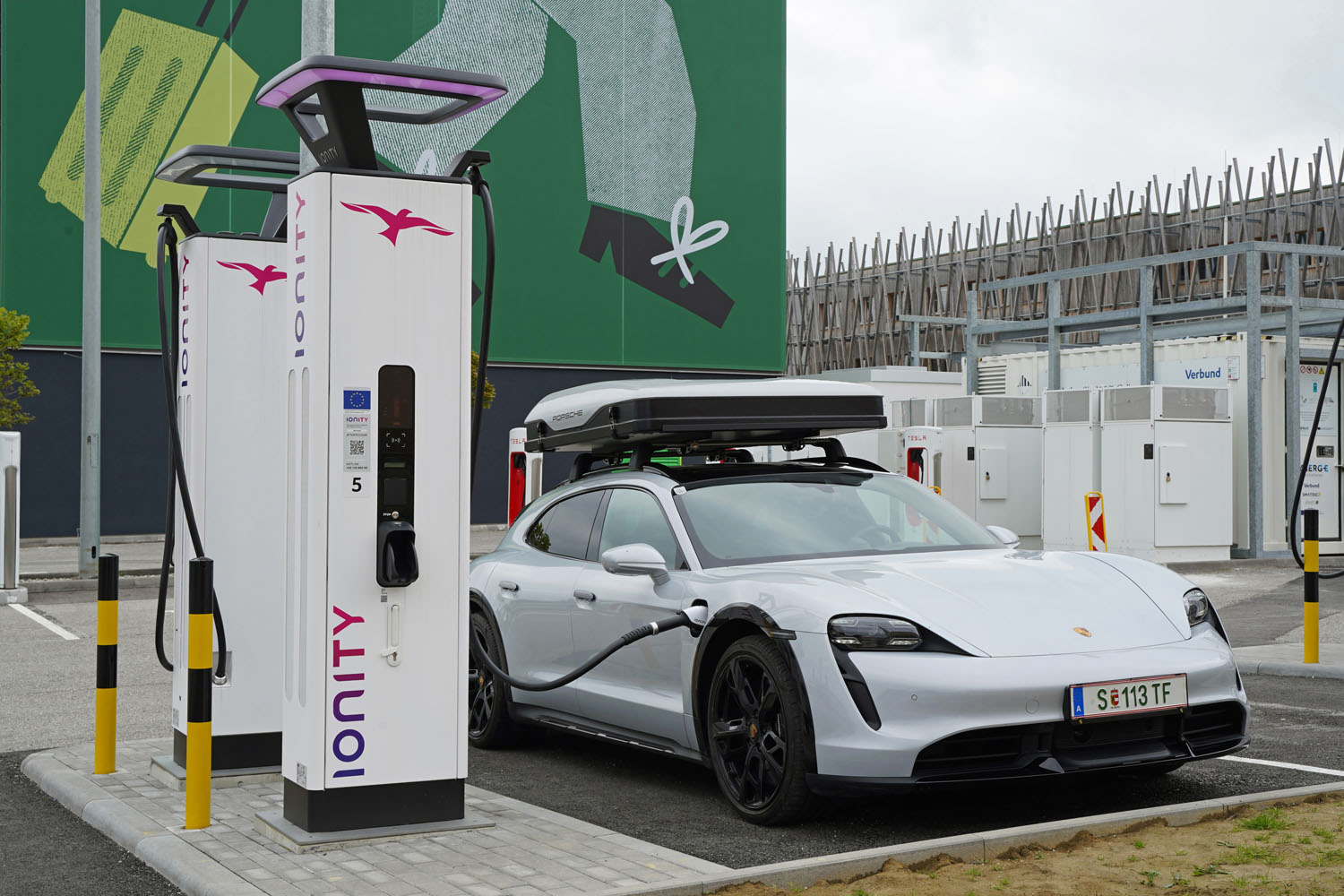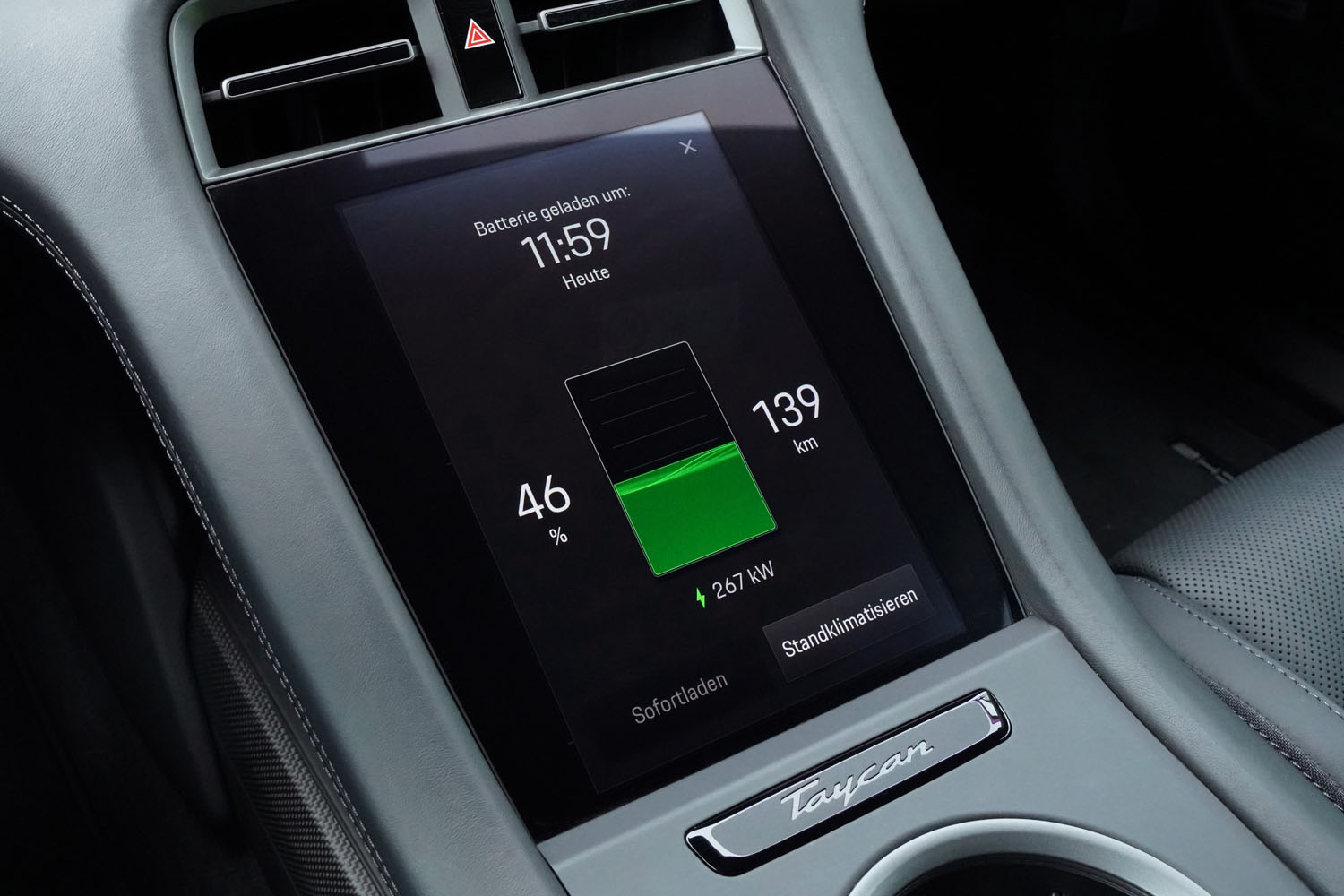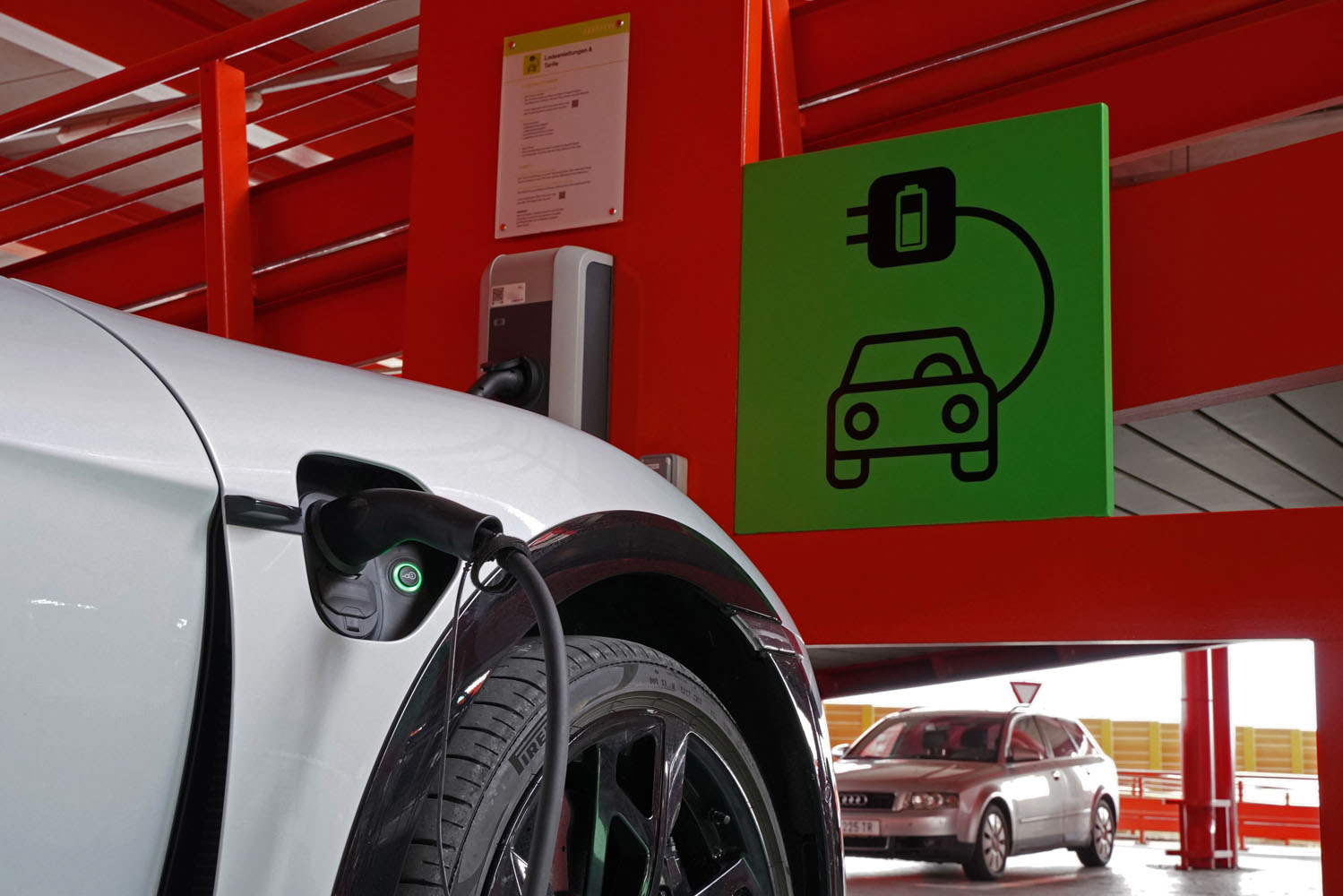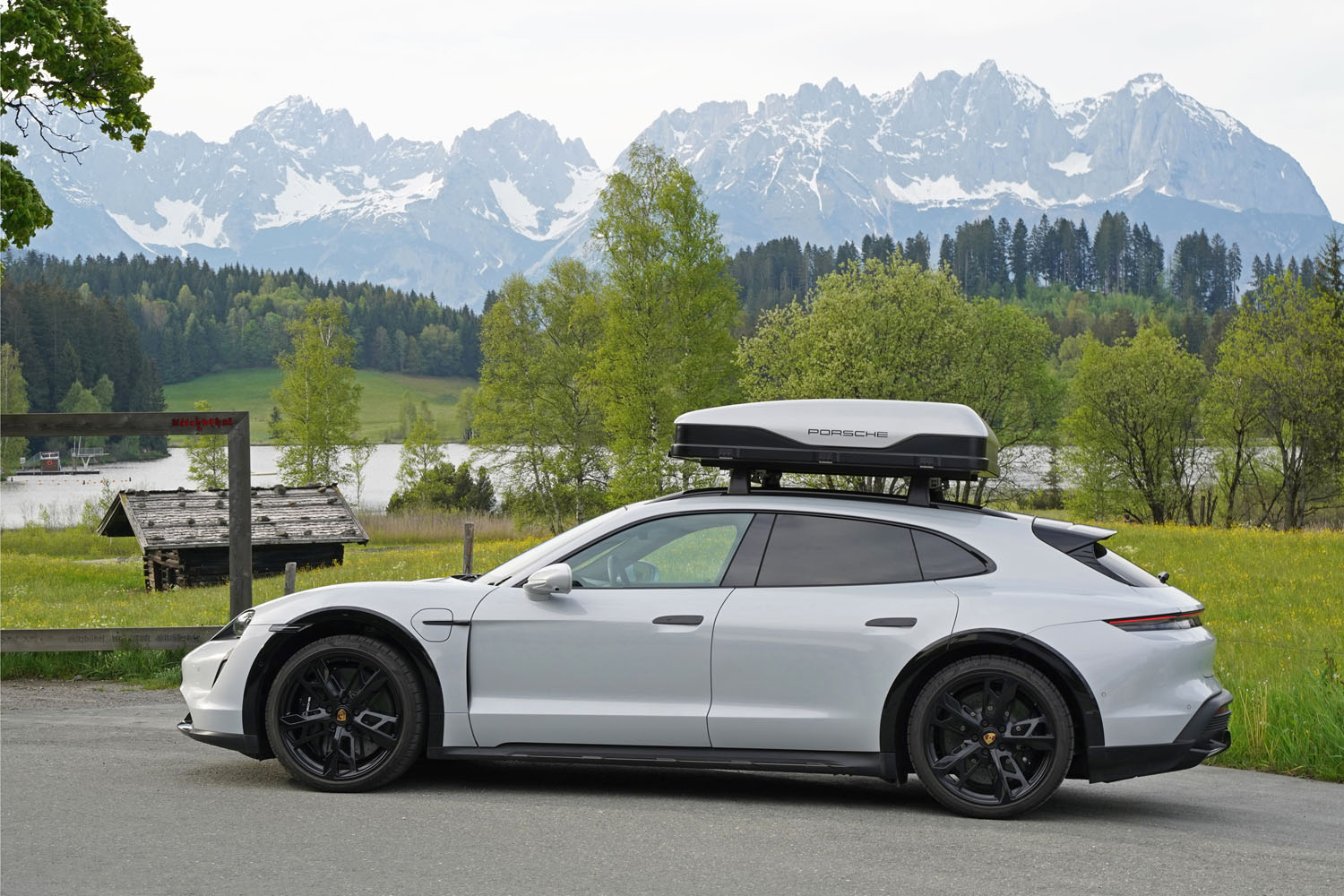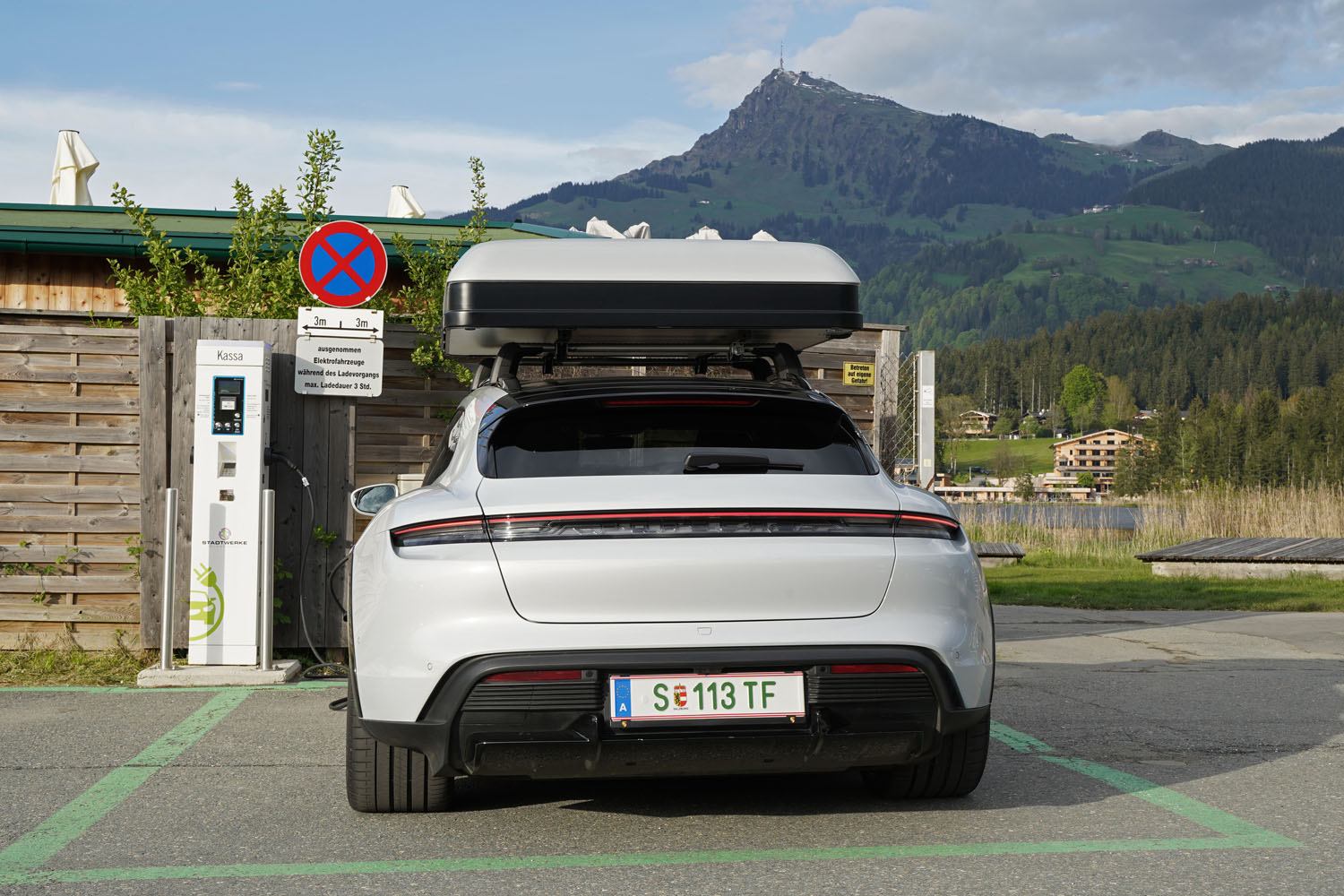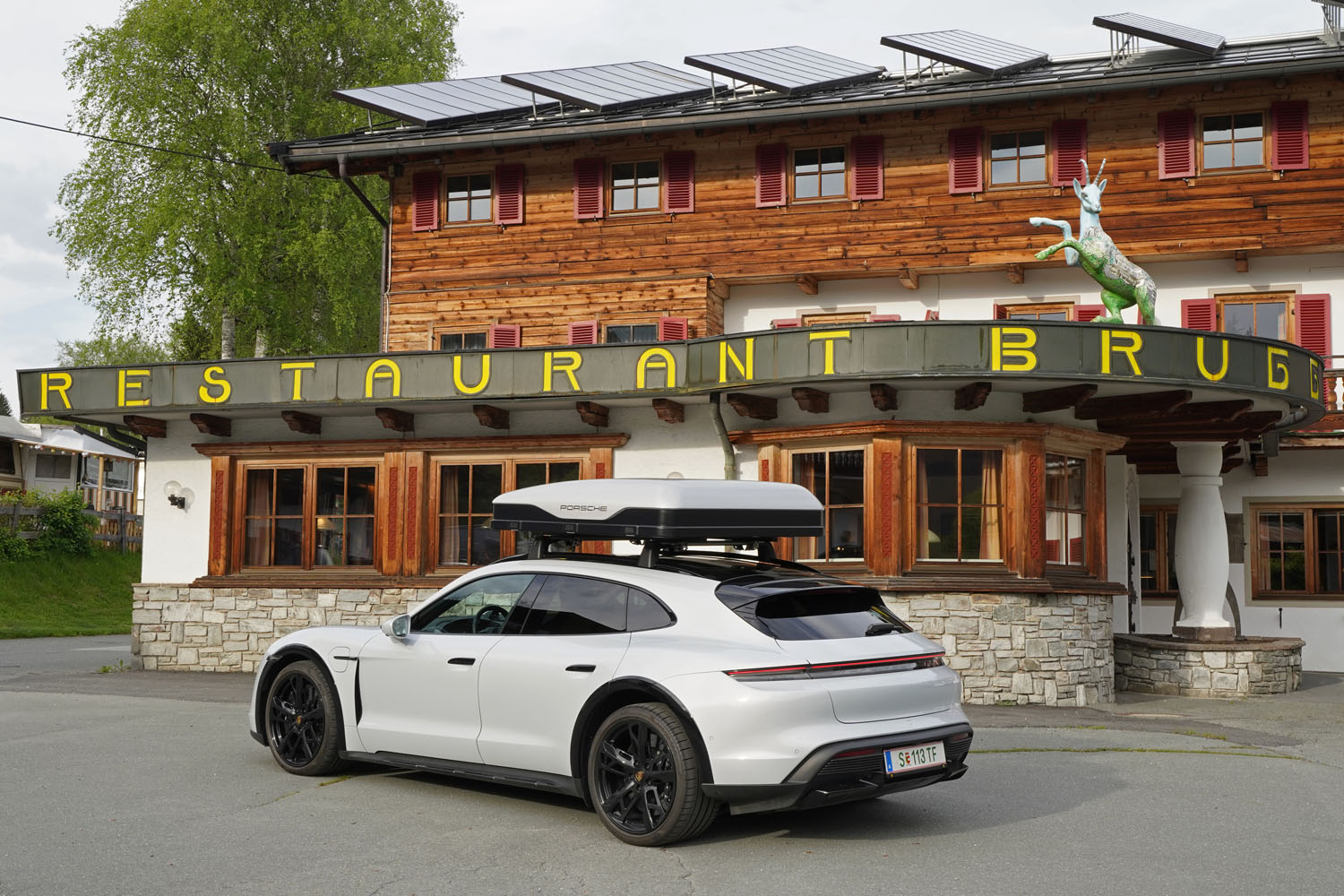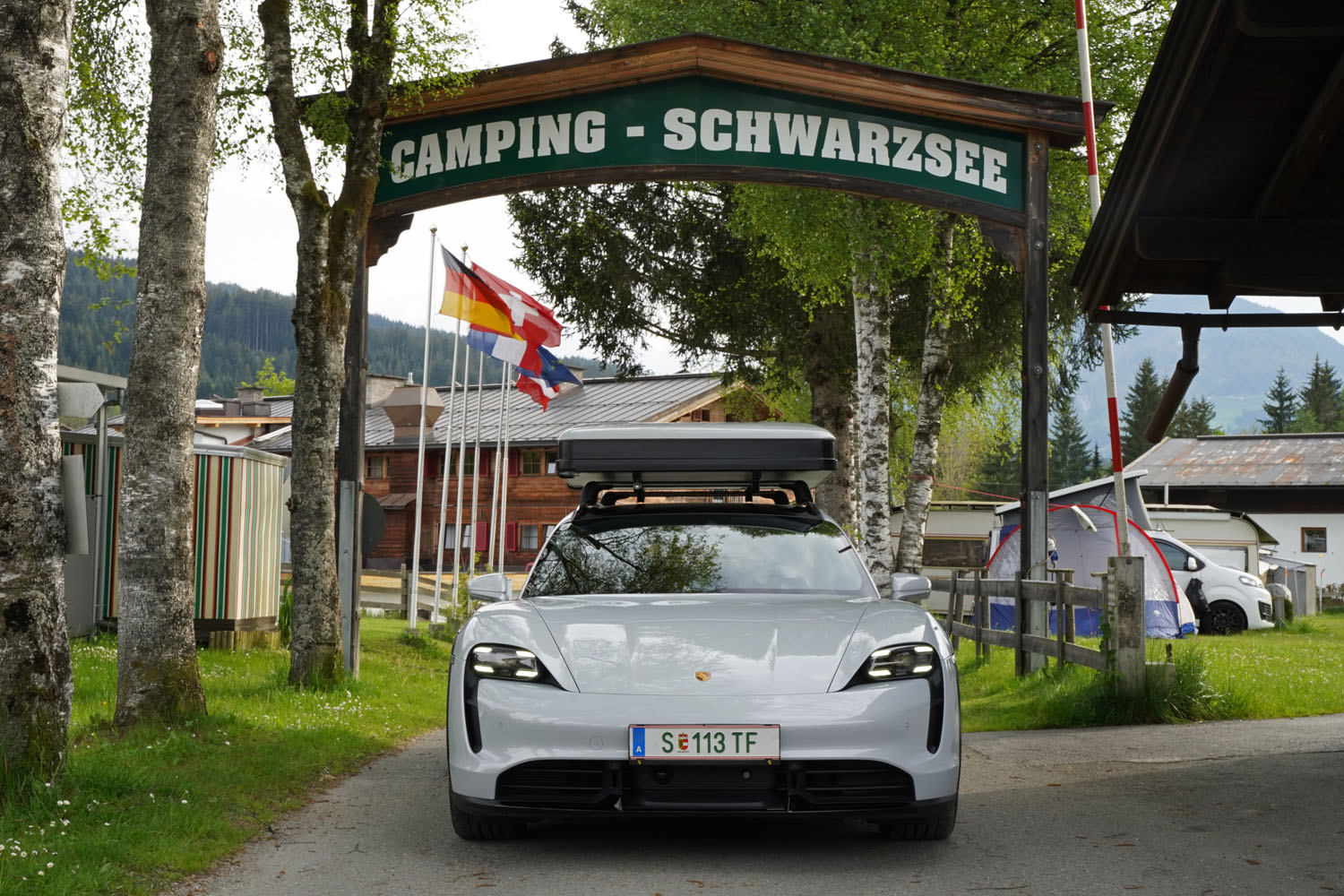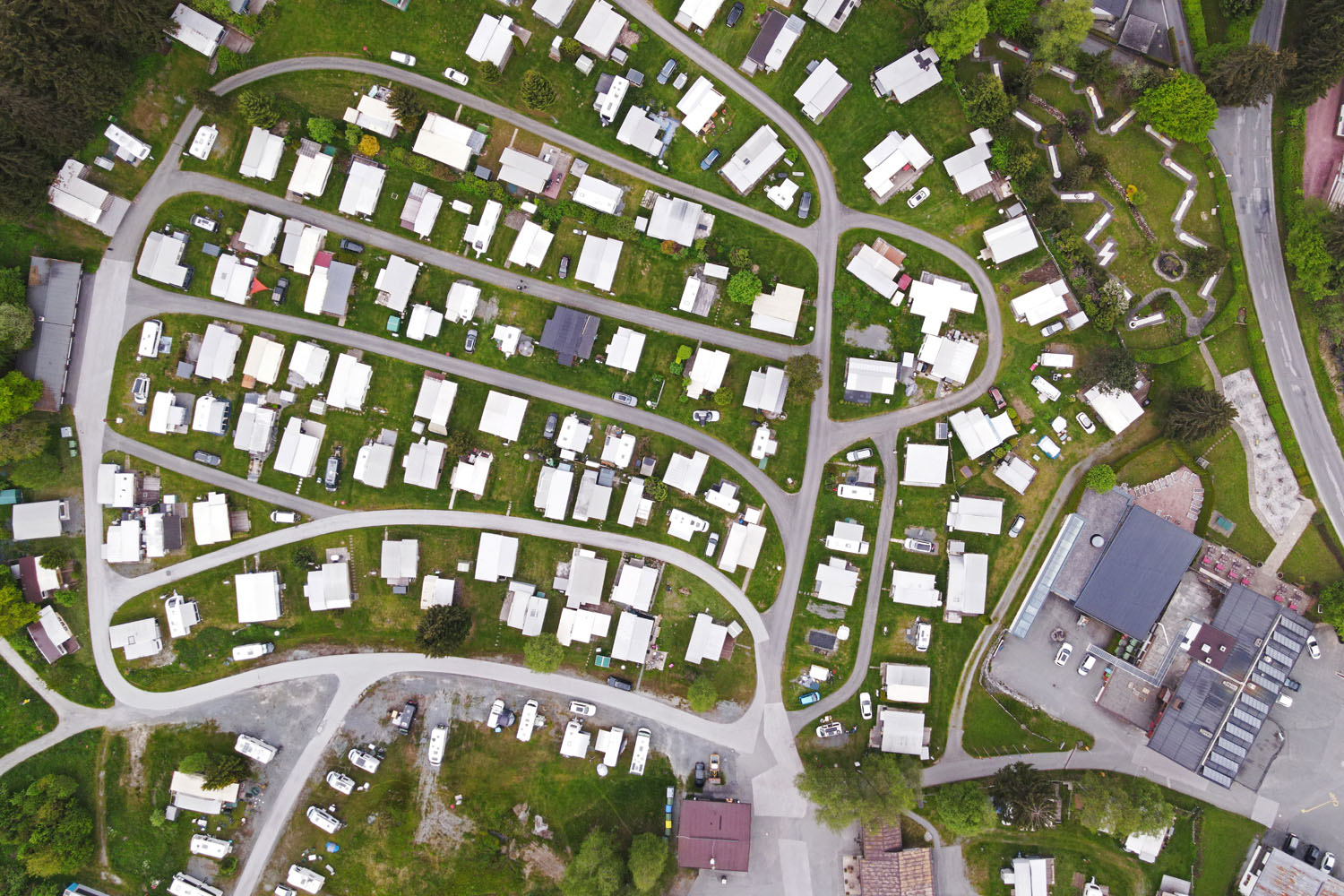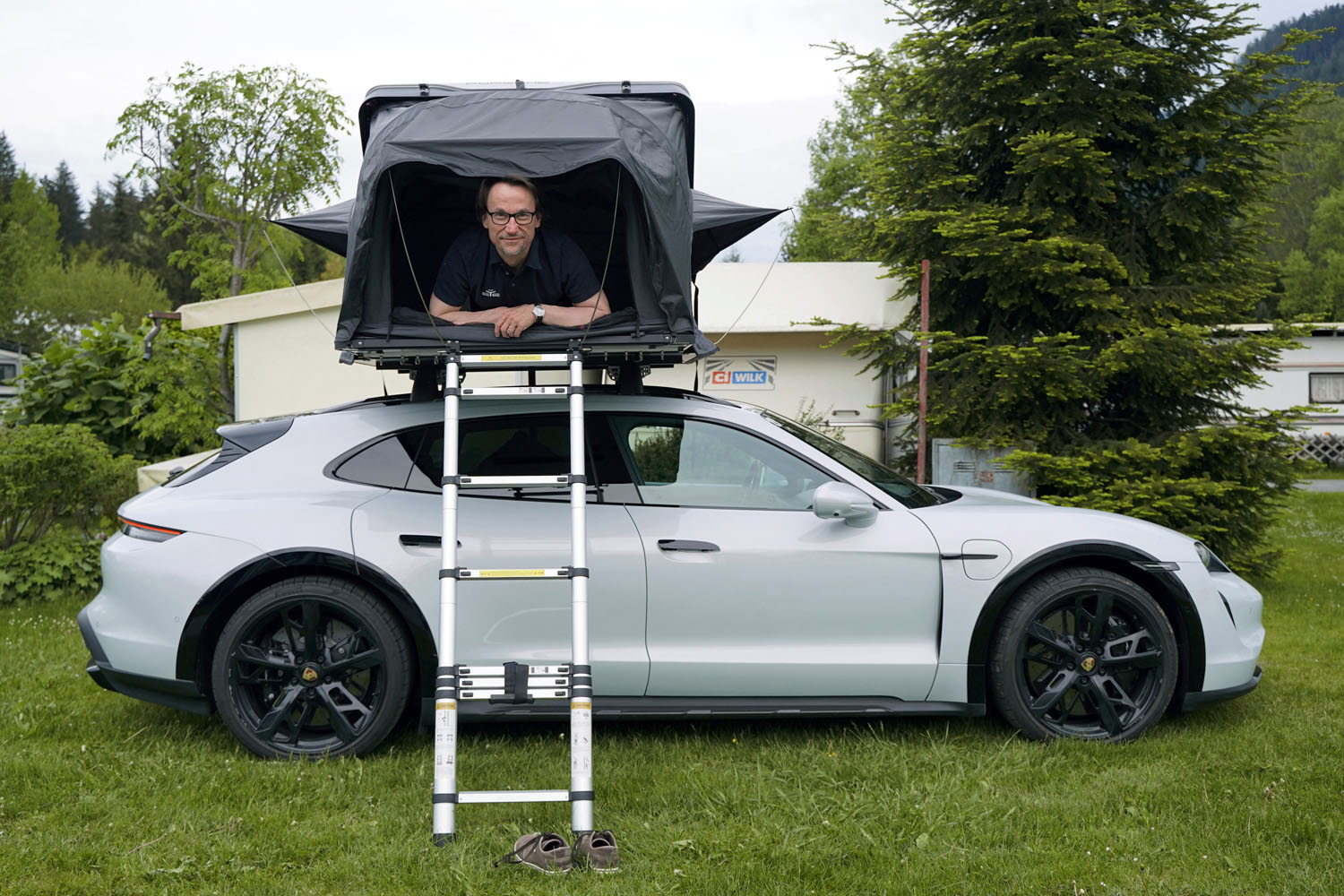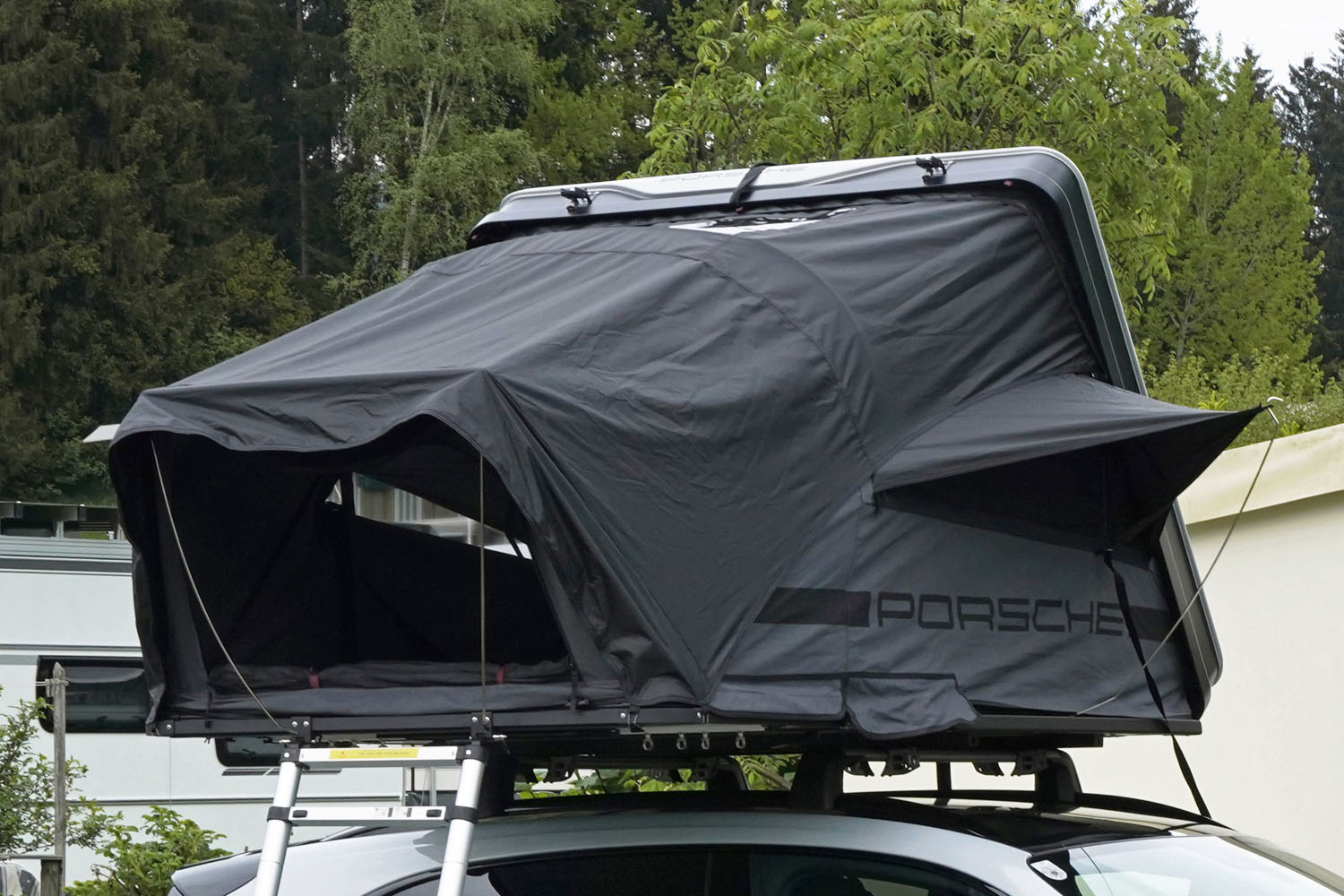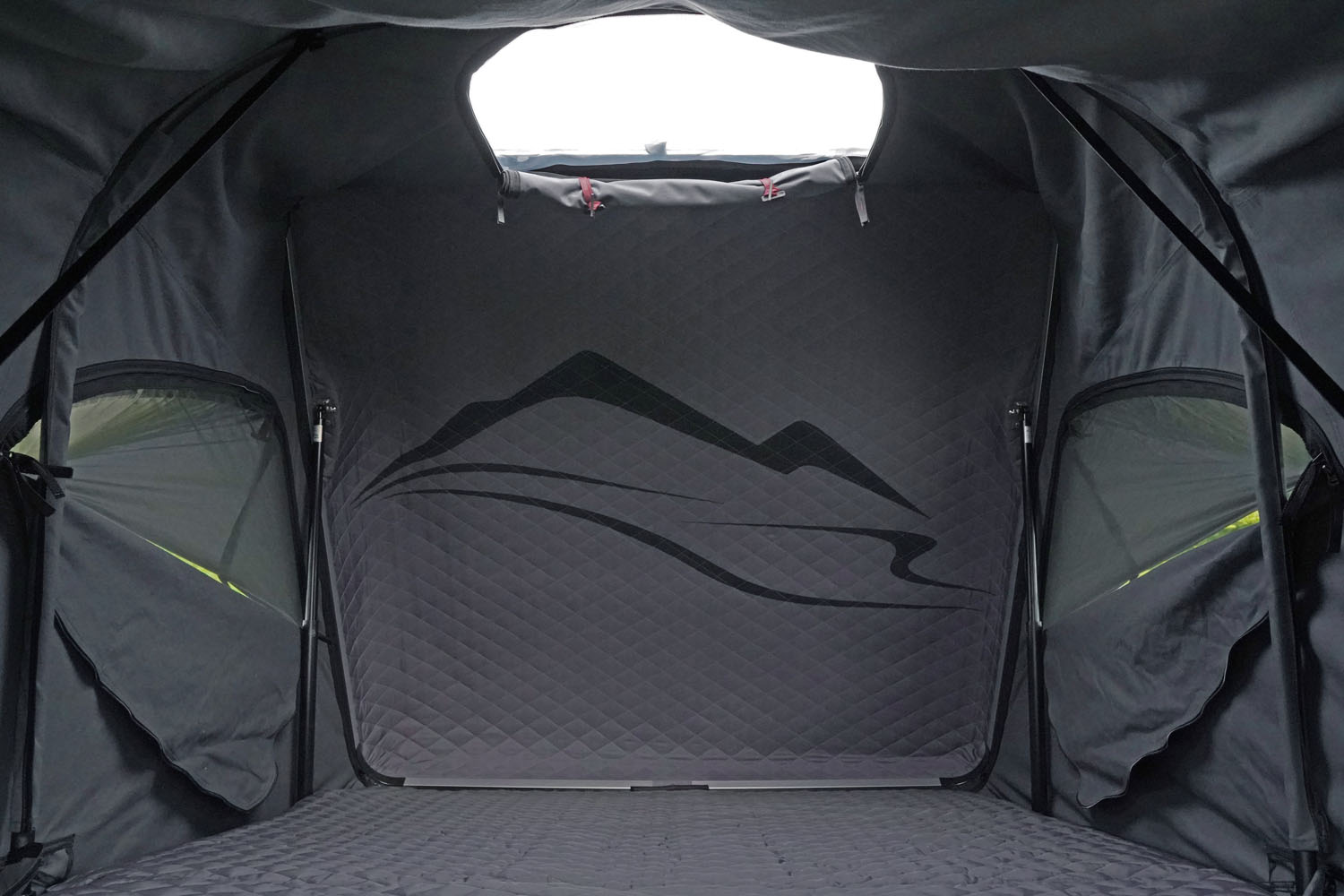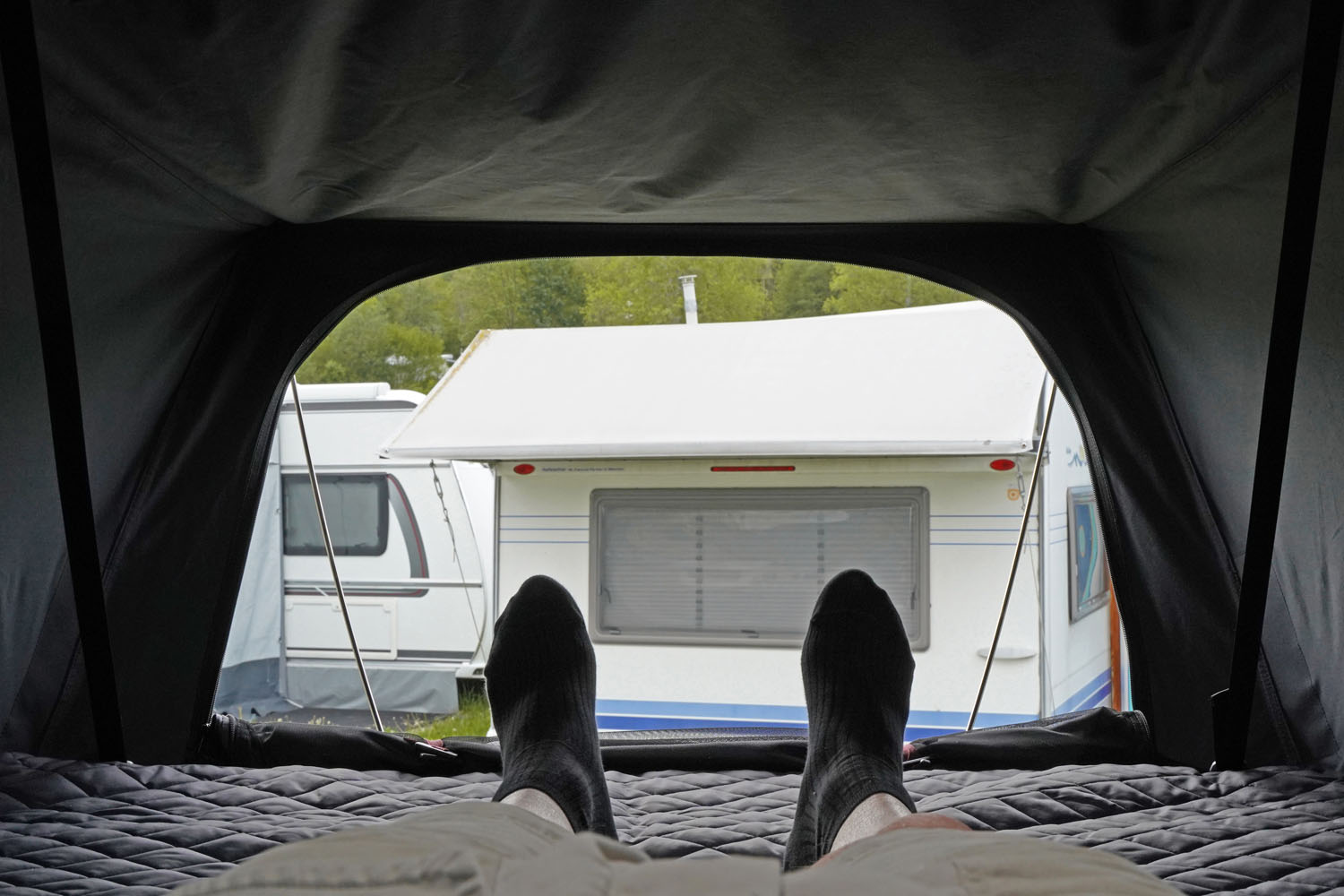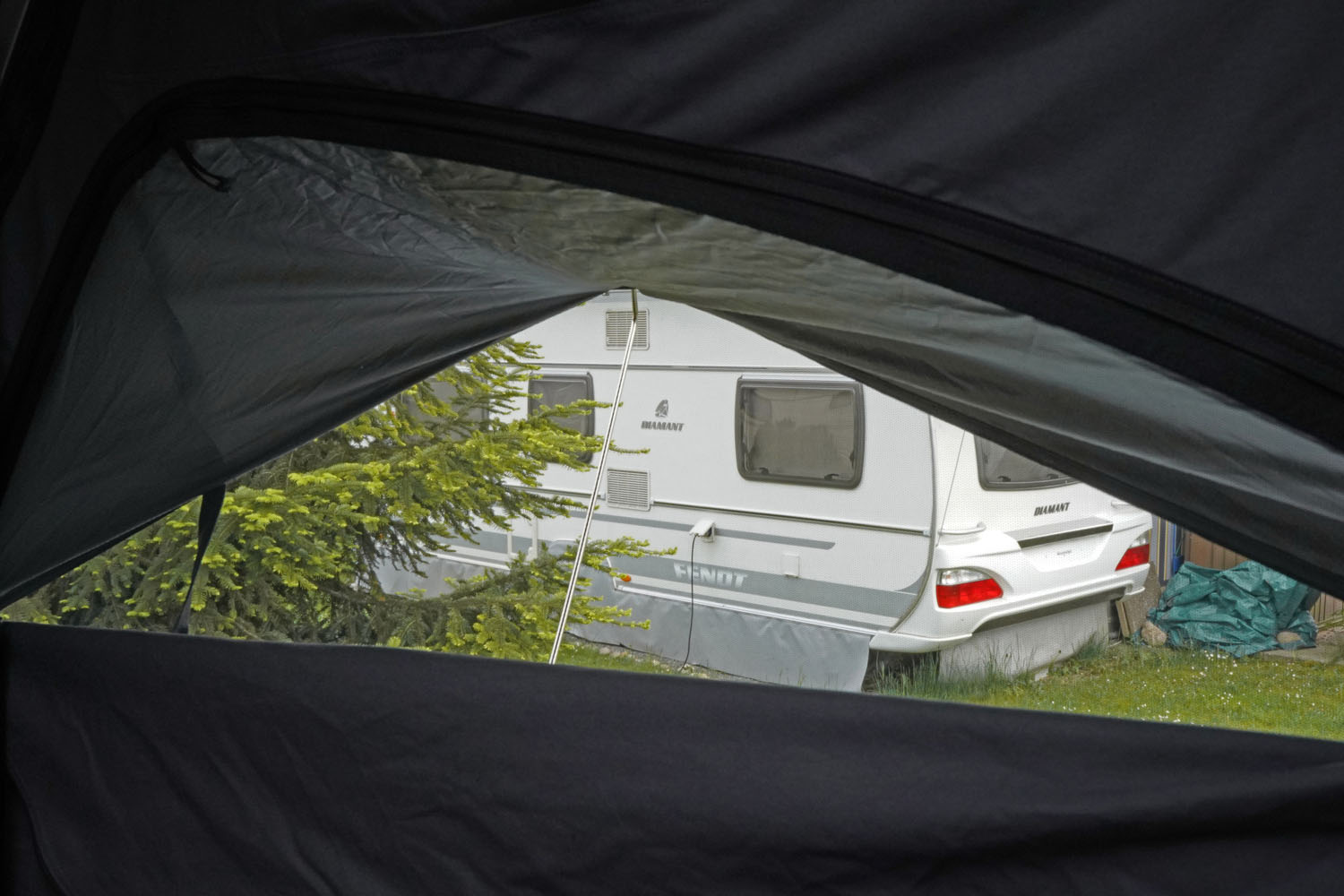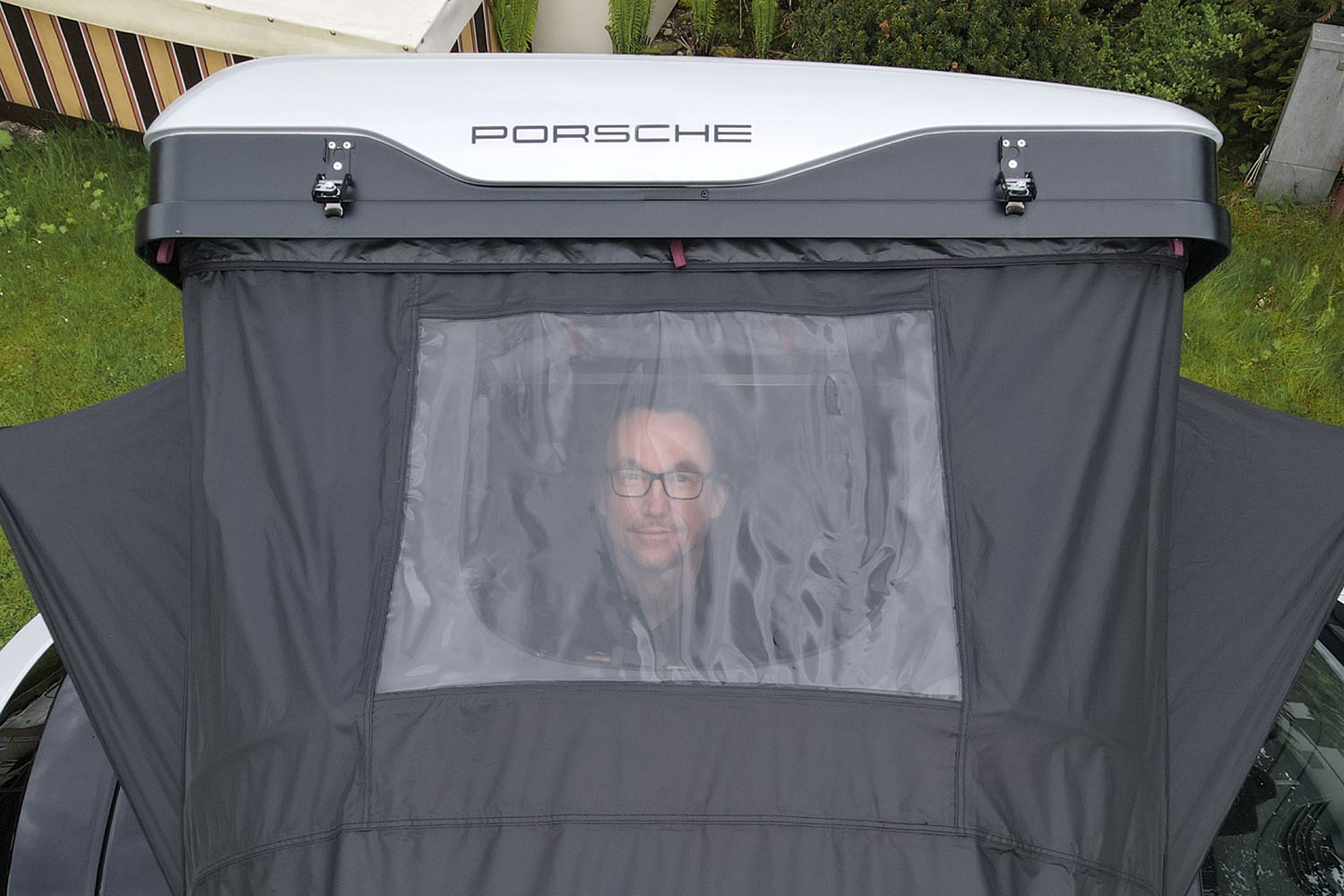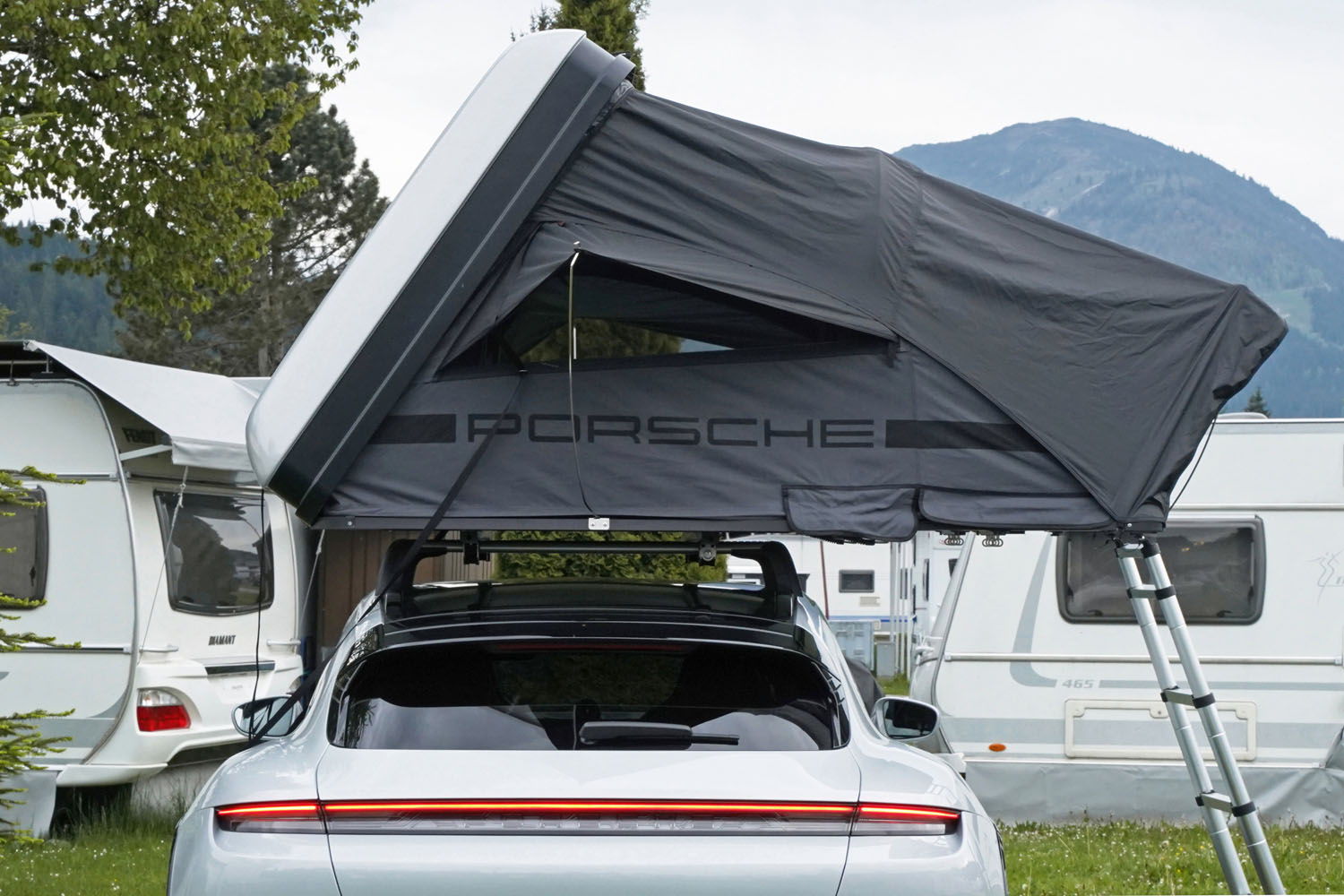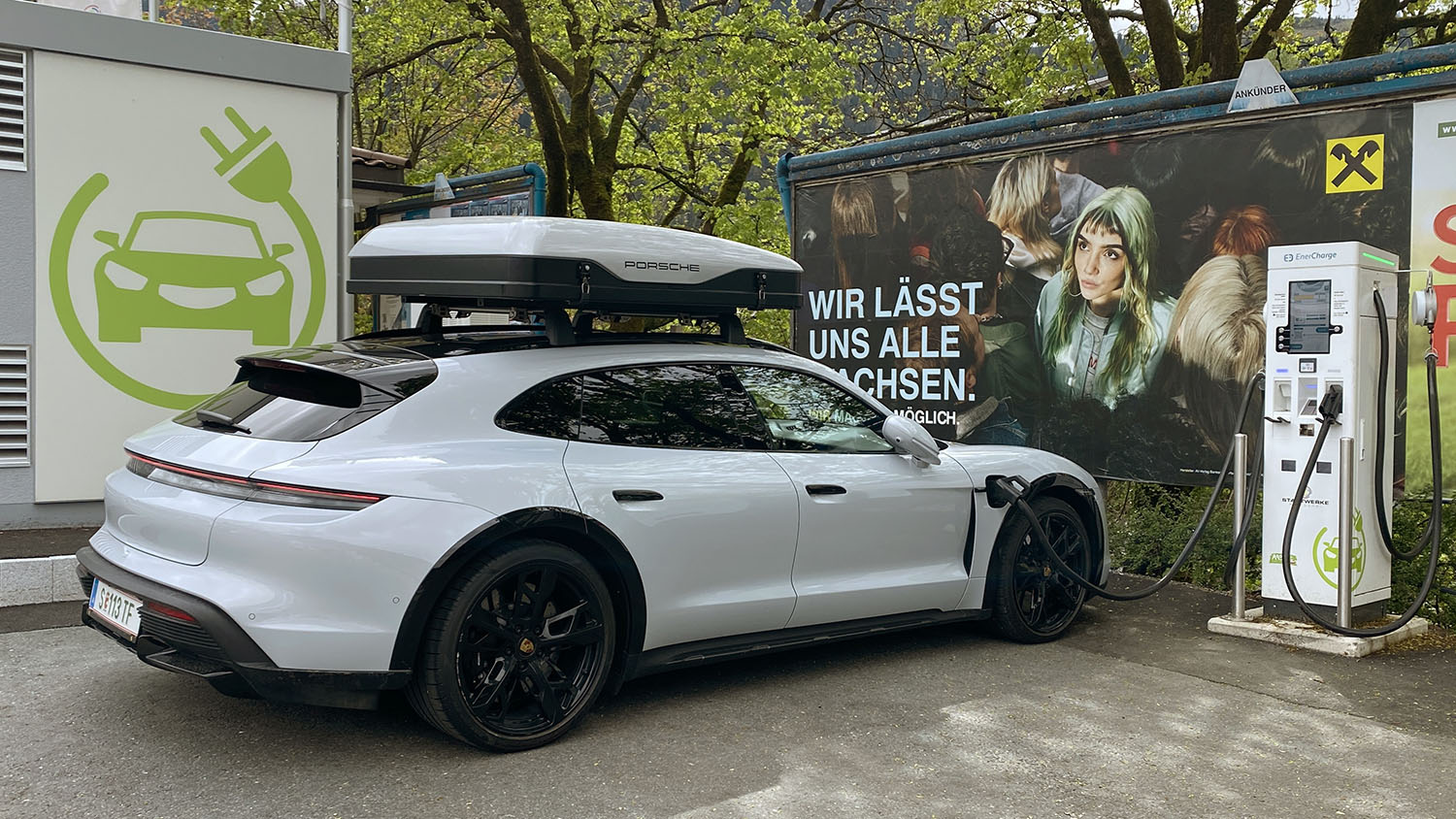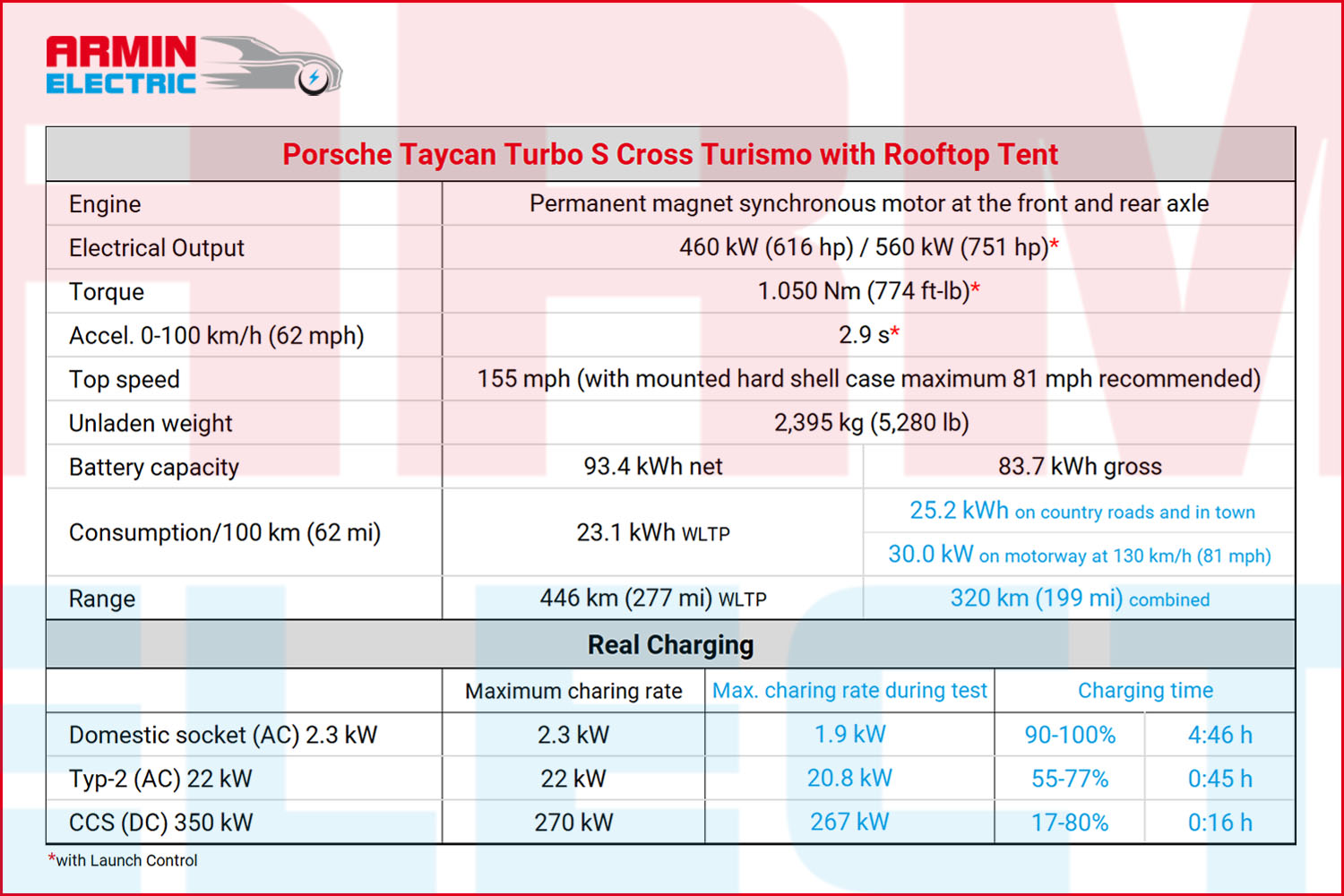Kitzbühel | Tyrol, Austria – Zero to 100 km/h (62 mph) in under three seconds; and car to tent in under three minutes – camping doesn’t get much sportier than that. The Porsche Taycan Turbo S Cross Turismo, along with its roof tent, makes it all possible. I was able to test the super-sporty station wagon and the mobile dwelling for you…
At the beginning of 2020, the four-door Porsche Taycan sports sedan was launched as the brand’s first purely electrically powered vehicle. The Cross Turismo station wagon version and the first Porsche e-bike followed just over a year later. Last summer, I tested the revised version of the Taycan-inspired eBike Cross (click here for the test report…). This time, the car itself had its turn, but it was what was mounted on top that grabbed attention: the new, Porsche-made roof tent.
Porsche Austria provided me with the top model of the series, the Taycan Turbo S Cross Turismo, in the color “ice gray metallic,” which feels appropriately named as it shimmers a faint light blue under the right kind of light. Visually, the black/light gray hard shell case that houses the tent fit very well into the aesthetic. As with the e-bike, Studio F. A. Porsche, headquartered in Zell am See, was also involved in the design of the hard case. Black accent colours on the car and 21-inch wheels rounded off the overall design nicely.
FOLLOWING THE CALL TO ADVENTURE
The tent-covered Cross Turismo, which is suitable for light terrain, awakened a real outdoor feeling in me. So after running a few errands in Linz, I set off from there for a camping weekend at Schwarzsee in Kitzbühel. The 446-liter trunk easily accommodated all the necessary camping equipment. With the rear seats folded down and thus a capacity of 1,212 liters, I could also have taken my mountain bike with me in the car. But this time it stayed at home. If the already ample trunk volume isn’t enough, there’s an additional 84-liter storage space under the hood.
…WITH A TENT ON TOP
The hard case with the tent weighs 56 kilograms and can be mounted securely on the basic rooftop carriers of the Porsche models Taycan, Macan, Cayenne, Panamera and 911 with the supplied mounting brackets. This is possible on vehicles with and without roof rails. The advantage of having roof rails, as my test vehicle did, is that they allow the full 190 kilograms that the tent adds. Compared to the approximately 140 kilograms (310 lbs.) without roof rails, where it can be tight for two people with luggage. Porsche recommends against driving faster than 130 km/h (80 mph) with the hard case mounted, though it is not a restriction on Austrian roads.
SUPER SPORTS CAR IN DISGUISE
When I got in, I landed quite low down in the fine leather seats, signalling that I was in a sports car. The ventilated sports seat has every conceivable electrical adjustment option; even the side bolsters of the backrest and seat can be adjusted. So you can either sit completely relaxed on long drives, or tighten up your position for sportier occasions. On the way out of town, I made a quick detour to the Porsche Centre of Upper Austria before hitting the Westautobahn in Traun. The standard air suspension in the “Normal” setting let me glide smoothly through the Friday afternoon traffic. The activated distance cruise control with traffic sign recognition and the lane departure warning system made traveling even more comfortable.
Able to sprint from 0 to 100 km/h in 2.9 seconds, the Taycan Turbo S Cross Turismo is a true super sports car. This is made possible by the overboost power of 560 kW (751 hp) when Launch Control is activated. During my test, the 2.4-ton car literally dug into the asphalt after releasing the brake pedal when I turned on Launch Control. Suffice it to say, I was catapulted forward and pressed into the seat at 1.1 g (see video below). Accelerating to 100 km/h (62 mph) in under three seconds is definitely not for the faint of heart and should be done only carefully on public roads. To match this, the ceramic brakes fitted as standard in the Turbo S decelerate with impressive strength. At the front, the brake pads are pressed by 10 pistons onto 420 mm ceramic composite brake discs, which enables the indescribably high braking power.
TURBO-CHARGED CHARGING SPEED
Since I had started that day with a low battery level, I was due for my first charge stop in Eberstallzell. I reached the 350 kW Ionity fast charging station with a battery charge level of 17 percent. The Taycan charged at a breathtaking speed thanks to its 800 V technology. In just 16 minutes, 55 kW had been charged with direct current and the battery had reached 80 percent SoC again. The maximum charging power was an impressive 267 kW. In Salzburg, I took advantage of a shopping break at Europark for another refueling stop. I arrived at the 22kW da emobil charging station located at the parking deck with 55 percent SoC. With the 22kW on-board AC charger, which is part of the additional equipment, I was able to achieve a very practical charging power of 20.8 kW with the charging cable I had brought along. In 45 minutes, the battery was filled with an additional 22 kWh. With 77 percent SoC and a range of 228 kilometers (142 miles), I was well equipped for a camping weekend with smaller day trips.
After the “Kleines Deutsches Eck” and St. Johann in Tirol, I soon reached the entrance to Kitzbühel. Shortly after the tunnel in the direction of Brixental, I arrived at Schwarzsee. There, I was immediately met with a magnificent view of the Wilder Kaiser. Directly in front of the lido are two charging stations belonging to the city of Kitzbühel. During a charge, you can walk along the lake and enjoy the view of the Kitzbüheler Horn mountain.
SUSTAINABLE CAMPING AT LAKE SCHWARZSEE
A few hundred meters later, I reached the Schwarzsee campsite, which belongs to the Biohotel Bruggerhof. The hotel is managed by the third generation of the Reiter family. Beautifully situated in the nature reserve “Moor am Schwarzsee”, the lake can be accessed on foot in just a few minutes through a small piece of forest. The 70,000 m² (17 acre) large area has everything else that the camper’s heart could desire, including a wellness area with an indoor pool, whirlpool, fitness room and several saunas.
Following the natural philosophy of the Reiter family, only sustainable and 100% organic products are offered in the restaurant as well as in the grocery store “BioGreißler”. And those without tent, camper or caravan can stay either in the Biohotel or in the Mobile Homes built of natural wood. The Nordic-inspired “igloo huts” offer space for up to four people. Recently, the campsite has also begun renting e-bikes. Altogether, the whole package makes for a very sustainable vacation.
CAR-TO-TENT IN JUST MINUTES
After Rene from the campsite had assigned me a nice pitch, I immediately began working on setting up the roof tent. First, I unlocked the safety latches and opened them. After lifting the lid of the box slightly, it swung upwards on its own with the help of two gas pressure dampers. Next, I folded out the telescopic ladder and with it immediately the foot part of the lower floor. Then, I just put the mattress in the right position and the “bed” was ready. The four spring rods practically stowed away in a compartment at the front. With these, I stretched the tarp over the canopy to the two side windows. After these few steps, the tent was up in less than three minutes. For a detailed setup description, check out the roof tent’s user manual.
Using the stable telescopic ladder, I climbed into the tent. Now it was time to try out the mattress. Made of high-density polyfoam, it immediately felt comfortable for camping. The spaciously designed lying surface of 210 x 130 centimetres, which fits two people, provided additional comfort. The tent walls are made of breathable cotton blend fabric, and there is an additional waterproof rain cover over the roof and entrance. The interior is lined with well-insulated quilted lining. The two side windows gave me an additional view outside. All openings have insect screens that can be fully opened for ventilation. Another highlight is the sky-view window, which opens up to a view of the starry sky as you lie down. As the temperatures in Kitzbühel dropped to as low as five degrees this weekend in May, it was still clearly too cold for a comfortable night in the tent. So, with a heavy heart I decided to postpone the first overnight stay in the Porsche roof tent to a later date.
Before driving home, I refuelled at the Sportpark in Kitzbühel. The city of Kitzbühel operates a fast-charging park with four charging stations at the P6 Kapser Kreisel parking lot. The 100 percent renewable electricity comes from AAE Naturstrom, and the charging columns from EnerCharge. I started the charge at a battery level of 14 percent. The maximum charging power of 194 kW set in at 22 percent SoC. After 26 minutes, the battery had reached 80 percent. I used the time for a walk through Kitzbühel. Right as I got back to the car, the battery level hit 100 percent after a total of 48 minutes and the display showed a range of 313 kilometres (195 miles). This allowed me to make a return trip without a charging stop.
ARMIN ELECTRIC CONCLUSIO
All in all, I drove the Taycan just over 1,500 kilometres (932 miles). And what can I say? It’s hard to describe the experience without using superlatives. Extremely high-quality and excellently finished materials, super-sport performance in terms of acceleration and chassis. With generous space for passengers and luggage, the Cross Turismo is a real all-around winner, and the roof tent makes it even more versatile. The tent is also built to a very high standard and gives two people comfortable, built-in accommodation. And the fact that it’s not complicated to set up makes camping even more fun.
Less fun was the Taycan’s high fuel consumption, which was naturally a bit higher due to the air resistance of the roof box. But if you want to go on a carefree vacation with a roof tent, consumption and the associated range play a significant role. At 30 kWh/100 km at a highway speed of 130 km/h (81 mph) and 25 kWh/100 km combined when factoring in city driving, even the Performance Battery Plus with a usable gross capacity of 83.7 kWh only allows a range of slightly more than 300 kilometres (186 miles).
On the main traffic routes with sufficient fast charging options, this may not be a problem due to the Taycan’s high charging speed. However, as soon as you venture into somewhat more remote areas for an outdoor adventure, it may well become an issue.
Pricing with all-wheel drive starts at 118,000 euro with the Taycan 4S in Austria (£95,200 in the UK, $118,200 in the US). The current base price of the top Turbo S Cross Turismo version I tested is 203,000 euro (£149,300 in the UK, $197,500 in the US). With the extensive additional equipment, the test vehicle came in at 222,000 euro. The two-person tent, which is fit for year-round use, can be ordered in Austria from Porsche sales partners for 5,269 euro (£4,635 in the UK, $7,029 excl. tax in the US).
Text, photos and video: Armin Hoyer – arminelectric.com
Translation from German to English: Ethan Shenhar


